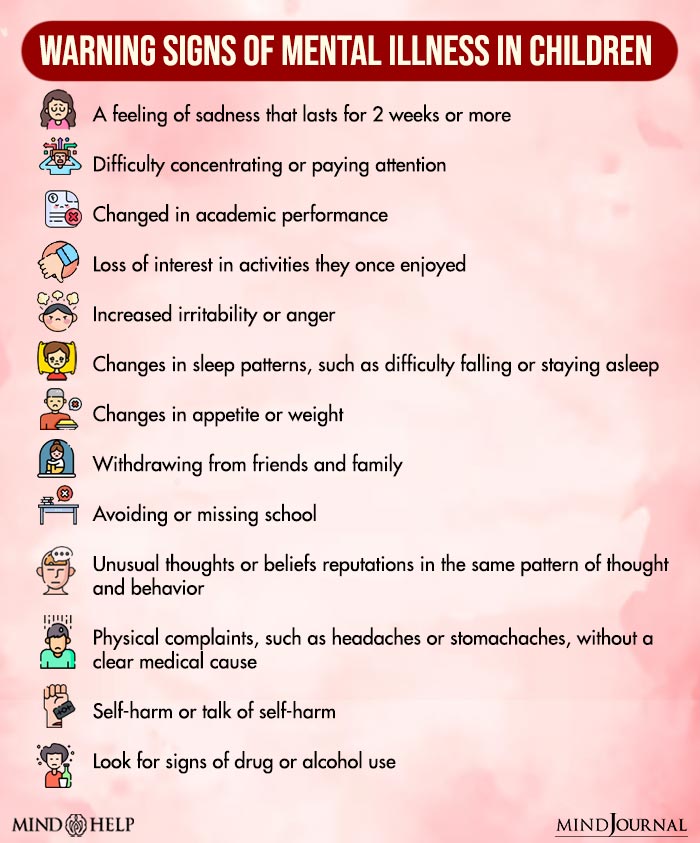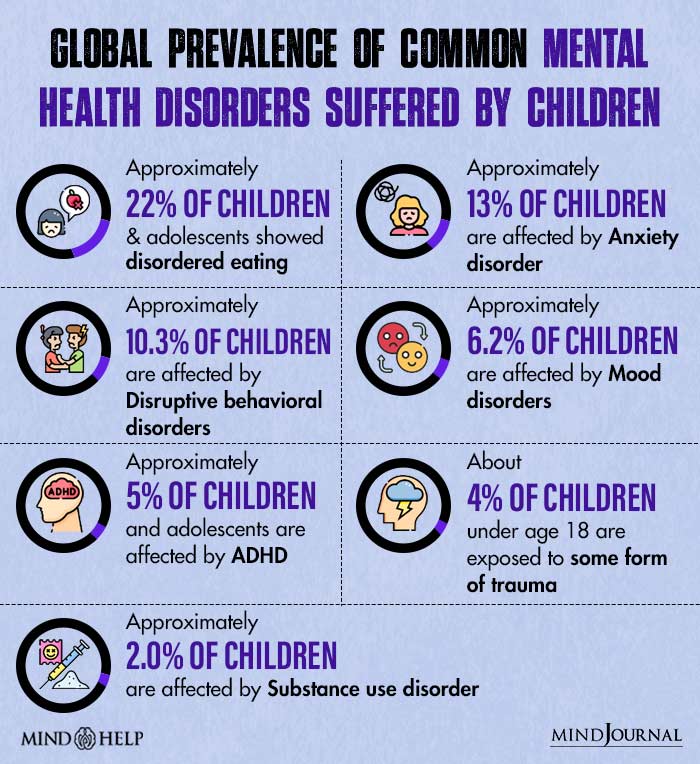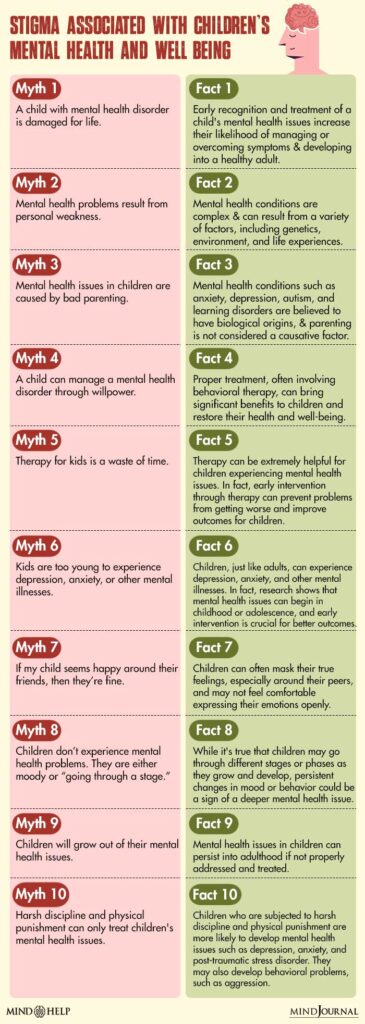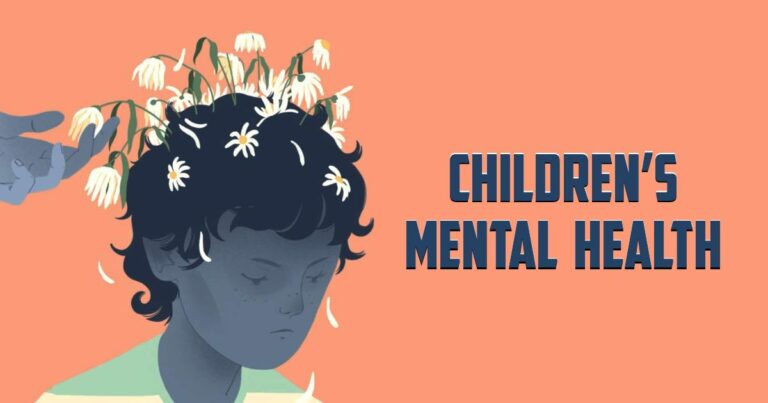Children’s mental health awareness involves recognizing and valuing the importance of mental well-being in young individuals. It encompasses increasing awareness and understanding of mental health challenges that children face, as well as emphasizing the significance of early intervention and prevention strategies.
What Is Children’s Mental Health Awareness?
The mental health of children is significantly important as it affects a child’s development and well-being. However, mental health problems in children often go unnoticed or undiagnosed due to a lack of awareness and understanding.
Globally, 17.4% (1 in 6) of children between the ages 1 CHILD AND ADOLESCENT MENTAL HEALTH. (2022). In www.ncbi.nlm.nih.gov. Agency for Healthcare Research and Quality (US). Available from: https://www.ncbi.nlm.nih.gov/books/NBK587174/ of 2 and 8 have a diagnosed mental, behavioral, or developmental disorder, highlighting the importance of addressing children’s mental health.
Furthermore, it is important to remember that children may not always be able to tell us how they are feeling about their mental health. This means that caregivers and mental health professionals need to pay extra attention and provide extra help to make sure that children get the support they need.

Common Mental Health Disorders Suffered By Children
Mental health professionals may address developmental disorders in children 2 Reiss A. L. (2009). Childhood developmental disorders: an academic and clinical convergence point for psychiatry, neurology, psychology and pediatrics. Journal of child psychology and psychiatry, and allied disciplines, 50(1-2), 87–98. https://doi.org/10.1111/j.1469-7610.2008.02046.x , which can encompass the following conditions:
1. Anxiety Disorder
Children with anxiety disorders experience 3 Bhatia, M. S., & Goyal, A. (2018). Anxiety disorders in children and adolescents: Need for early detection. Journal of postgraduate medicine, 64(2), 75–76. https://doi.org/10.4103/jpgm.JPGM_65_18 persistent fears, worries, or anxious apprehension that hinder their ability to engage in age-appropriate social situations, play, or school.
Read More About Generalized Anxiety Disorder Here
2. ADHD (Attention Deficit Hyperactivity Disorder)
A neurodevelopmental disorder that is usually diagnosed in childhood and often continues into adulthood and is characterized by symptoms of inattention, hyperactivity 4 Drechsler, R., Brem, S., Brandeis, D., Grünblatt, E., Berger, G., & Walitza, S. (2020). ADHD: Current Concepts and Treatments in Children and Adolescents. Neuropediatrics, 51(5), 315–335. https://doi.org/10.1055/s-0040-1701658 , and impulsivity that can affect the daily functioning of children.
Read More About ADHD Here
3. Autism Spectrum Disorder (ASD)
Children with ASD may have difficulty with social cues, impaired social interaction 5 Mughal, S., Faizy, R. M., & Saadabadi, A. (2020). Autism Spectrum Disorder (Regressive Autism, Child Disintegrative Disorder). PubMed; StatPearls Publishing. Available from: https://www.ncbi.nlm.nih.gov/books/NBK525976/ , communication difficulties, and repetitive behaviors or interests. It is usually diagnosed in early childhood, between the ages of 2 and 6.
Read More About Autism Here
4. Eating Disorders
Eating disorders often start in adolescence and are characterized by abnormal eating 6 Hornberger, L. L., Lane, M. A., & COMMITTEE ON ADOLESCENCE (2021). Identification and Management of Eating Disorders in Children and Adolescents. Pediatrics, 147(1), e2020040279. https://doi.org/10.1542/peds.2020-040279 habits and behaviors, including anorexia nervosa, bulimia nervosa, and binge eating disorder.
Read More About Eating Disorders Here
5. Depression and Other Mood Disorders
Depression refers to feelings of sadness and loss of interest 7 Lima, N. N., do Nascimento, V. B., de Carvalho, S. M., de Abreu, L. C., Neto, M. L., Brasil, A. Q., Junior, F. T., de Oliveira, G. F., & Reis, A. O. (2013). Childhood depression: a systematic review. Neuropsychiatric disease and treatment, 9, 1417–1425. https://doi.org/10.2147/NDT.S42402 , while bipolar disorder involves extreme mood swings between depression and elevated emotional/behavioral states that can be impulsive or risky, affecting a child’s social and academic functioning.
Read More About Depression Here
6. Schizophrenia
The onset of schizophrenia usually occurs in the late teenage years or early adulthood that is characterized by a breakdown 8 Kendhari, J., Shankar, R., & Young-Walker, L. (2016). A Review of Childhood-Onset Schizophrenia. Focus (American Psychiatric Publishing), 14(3), 328–332. https://doi.org/10.1176/appi.focus.20160007 in thought processes, problems in academic performance and abnormal perceptions of reality, such as delusions and hallucinations.
Read More About Schizophrenia Here
7. Post-Traumatic Stress Disorder (PTSD)
PTSD can occur at any age after a traumatic event 9 Fariba, K., & Gupta, V. (2021). Posttraumatic Stress Disorder In Children. PubMed; StatPearls Publishing. Available from: https://www.ncbi.nlm.nih.gov/books/NBK559140/ , such as abuse, violence, or a natural disaster, and is characterized by symptoms such as flashbacks, nightmares, and hyperarousal.
Read More About PTSD Here

Importance Of Raising Awareness About Children’s Mental Health
Here are some reasons 10 García-Carrión, R., Villarejo-Carballido, B., & Villardón-Gallego, L. (2019). Children and Adolescents Mental Health: A Systematic Review of Interaction-Based Interventions in Schools and Communities. Frontiers in psychology, 10, 918. https://doi.org/10.3389/fpsyg.2019.00918 why raising awareness about children’s mental health is crucial:
- To implement early intervention and treatment for mental health disorders in childhood and prevent symptoms from persisting or worsening into adulthood.
- To accurately recognize and interpret one’s own emotions.
- To encourage a positive attitude in children that helps promote fairness, honesty, and safe, healthy behaviors.
- As children grow, it’s important for them to develop strong decision-making skills, including the ability to assess situations, establish goals, and execute plans effectively.
- To prevent the risk of developing other problems 11 Schulte-Körne G. (2016). Mental Health Problems in a School Setting in Children and Adolescents. Deutsches Arzteblatt international, 113(11), 183–190. https://doi.org/10.3238/arztebl.2016.0183 such as substance abuse or delinquency which can cause by children’s untreated mental health issues.

Purpose of Celebrating Children’s Mental Health Awareness Week
Children’s Mental Health Awareness Week 12 Mazumder, A. H. (2015). Mental Health Awareness Week ? 11th to 17th May 2015 ? Overcoming Stigma. International Journal of Emergency Mental Health and Human Resilience, 17(2). https://doi.org/10.4172/1522-4821.1000e210 , recognized nationwide, aims to raise awareness and educate communities about the importance of children’s mental health crisis 13 Benton, T. D., Boyd, R. C., & Njoroge, W. F. M. (2021). Addressing the Global Crisis of Child and Adolescent Mental Health. JAMA Pediatrics. https://doi.org/10.1001/jamapediatrics.2021.2479 and their impact on families.
The National Association for Mental Health started a campaign 14 NIMH. (2017, February 17). National Institute of Mental Health (NIMH). National Institutes of Health (NIH). Available from: https://www.nih.gov/about-nih/what-we-do/nih-almanac/national-institute-mental-health-nimh in 1949 to promote mental health awareness. The Annual Green Ribbon Campaign, launched by the National Federation of Families, was another significant awareness 15 Collins, R. L., Wong, E. C., Breslau, J., Burnam, M. A., Cefalu, M., & Roth, E. (2019). Social Marketing of Mental Health Treatment: California’s Mental Illness Stigma Reduction Campaign. American journal of public health, 109(S3), S228–S235. https://doi.org/10.2105/AJPH.2019.305129 initiative.
Annually on May 7th, National Children’s Mental Health Awareness Day aims to increase awareness 16 Powers, J. D., Wegmann, K., Blackman, K., & Swick, D. C. (2014). Increasing Awareness of Child Mental Health Issues among Elementary School Staff. Families in Society: The Journal of Contemporary Social Services, 95(1), 43–50. https://doi.org/10.1606/1044-3894.2014.95.6 about the significance of mental health for kids and emphasize that positive mental health is crucial for their healthy development.
How do Parents Affect Their Children’s Mental Health
Parents play a crucial role in shaping their 17 Behere, A. P., Basnet, P., & Campbell, P. (2017). Effects of Family Structure on Mental Health of Children: A Preliminary Study. Indian journal of psychological medicine, 39(4), 457–463. https://doi.org/10.4103/0253-7176.211767 children’s mental health, such as:
- Parents who can identify signs of mental health issues in their children and seek appropriate help can prevent the issues from worsening.
- Parents who exhibit positive behaviors and coping mechanisms can help their children learn to do the same.
- Open and effective communication can help children feel heard, understood, and supported.
- On the other hand, chronic criticism, and negative reactions can harm a child’s self-confidence.
- Emotional neglect, such as ignoring a child’s emotional needs 18 Imran, N., Zeshan, M., & Pervaiz, Z. (2020). Mental health considerations for children & adolescents in COVID-19 Pandemic. Pakistan journal of medical sciences, 36(COVID19-S4), S67–S72. https://doi.org/10.12669/pjms.36.COVID19-S4.2759 , can cause feelings of loneliness and depression.
- Physical or emotional abuse can cause trauma 19 Mehta, D., Kelly, A. B., Laurens, K. R., Haslam, D., Williams, K. E., Walsh, K., Baker, P. R. A., Carter, H. E., Khawaja, N. G., Zelenko, O., & Mathews, B. (2023). Child Maltreatment and Long-Term Physical and Mental Health Outcomes: An Exploration of Biopsychosocial Determinants and Implications for Prevention. Child psychiatry and human development, 54(2), 421–435. https://doi.org/10.1007/s10578-021-01258-8 that can have lasting effects on a child’s mental health.
How does Social Media Affect Children’s Mental Health
The effects of social media 20 Bozzola, E., Spina, G., Agostiniani, R., Barni, S., Russo, R., Scarpato, E., Di Mauro, A., Di Stefano, A. V., Caruso, C., Corsello, G., & Staiano, A. (2022). The Use of Social Media in Children and Adolescents: Scoping Review on the Potential Risks. International journal of environmental research and public health, 19(16), 9960. https://doi.org/10.3390/ijerph19169960 on children’s mental health are a growing concern and can lead to:
- Disrupt sleep patterns of children, which can cause by maladaptive use of social media.
- Unrealistic expectations for children, particularly around body image, material possessions, and social status can contribute to low self-confidence.
- Exposure to harmful content such as violent or sexual content can also be distressing for children’s mental health.
Ways To Raise Awareness For Children’s Mental Health
There are various ways 21 Shastri P. C. (2009). Promotion and prevention in child mental health. Indian journal of psychiatry, 51(2), 88–95. https://doi.org/10.4103/0019-5545.49447 to raise awareness for children’s mental health, including:
- Organizing events such as workshops, seminars, webinars, and conferences to educate parents, teachers, and community members about children’s mental health issues.
- It’s important also to consider the potential effects of social media on children’s mental health while using platforms like Twitter, Facebook, Instagram, and LinkedIn.
- Organizing public awareness campaigns through local media, such as radio, newspapers, and TV stations.
- Working with schools to integrate mental health education into their curriculum and promote mental wellness among students.
- Engaging children in activities such as art therapy, group therapy, and support groups to help them express their emotions and cope with mental health challenges.
How To Teach Mental Health Awareness To Children?
Teaching mental health awareness to children can be done in various ways 22 Fazel, M., Hoagwood, K., Stephan, S., & Ford, T. (2014). Mental health interventions in schools 1: Mental health interventions in schools in high-income countries. The lancet. Psychiatry, 1(5), 377–387. https://doi.org/10.1016/S2215-0366(14)70312-8 , including:
- Make it clear that it is okay to show emotions and that they can share themselves without fear of judgment or punishment.
- Teach that mental health for kids is just as important as physical health.
- Use simple language and examples that are appropriate for the child’s age and developmental stage.
- Provide age-appropriate resources, such as books, videos, and websites, that teach them about children’s mental health crises and coping strategies.
- If a child is struggling with mental health issues, seek professional help from a therapist or counselor.
Takeaway
Prioritizing positive mental health for children is crucial through open communication, emotional regulation, healthy habits, and professional help when needed. Raising awareness about children’s mental health is also vital to eliminate stigma and provide the necessary support and resources for children to thrive.
At A Glance
- Children’s mental health is just as important as their physical health.
- Mental health disorders in childhood can persist into adulthood if left untreated.
- Common mental disorders in children include anxiety disorders, ADHD, autism spectrum disorder, depression, and eating disorders.
- Developing good decision-making skills, positive attitudes, and emotional awareness can promote healthy behaviors and prevent mental health problems among children.
- Parents, caregivers, and educators can play an essential role in promoting and maintaining children’s mental health.
- Activities and events can be organized to raise awareness and promote mental health education among children and communities.
Frequently Asked Questions (FAQs)
1. Where can parents and caregivers find resources and support for children’s mental health?
Resources and support for children’s mental health are available through healthcare providers, schools, community organizations, and mental health organizations such as the National Alliance on Mental Illness (NAMI). Online resources, such as websites and forums, can also provide helpful information and support.
2. What should parent avoid doing to improve their children’s mental health?
To improve their children’s mental health, parents should avoid using harsh criticism or being overly controlling. They should also provide emotional support, set realistic expectations, and seek professional help if needed.
3. What is the most important way of promoting the mental health of children?
There are many important ways to promote the mental health of children, but perhaps the most important is ensuring that they have a safe, stable, and supportive home environment, which includes providing them with proper nutrition, regular physical activity, adequate sleep, and emotional support.















